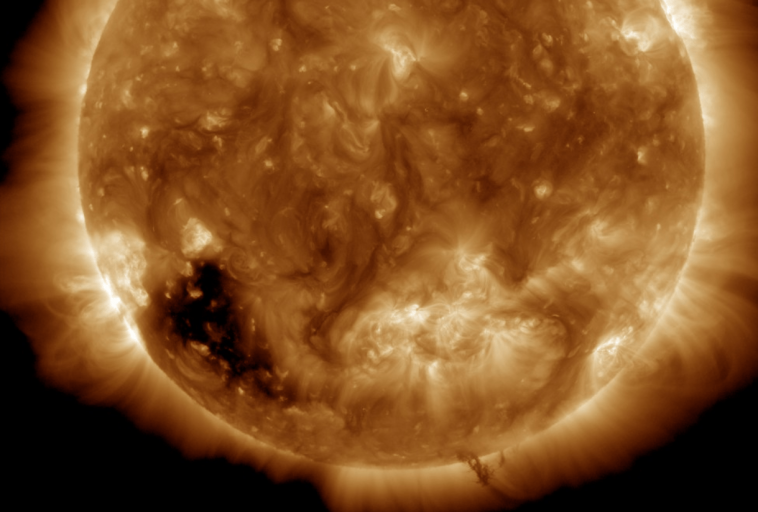Data from the National Oceanic and Atmospheric Administration’s Space Weather Forecasting Center monitoring solar activity shows that the frequency of the sun’s activity continues to rise. The question is, is this winter destined to be warm?
Of course, this question is about the “warmness” of the sun and the earth. It has to be said that changes in the frequency of the sun’s activities do have a certain impact on the earth.
Moreover, the activity state this time is not low. According to the trend, it is destined to “spend” this winter under the high frequency of solar activity.
So, this does have the potential to affect climate change, and how, let’s continue to see.
7 flares erupted in one day, and the sun shows a “giant coronal hole”
In a superficial sense, the appearance of the sun’s “coronal hole” is a sign of the sun’s changes.
From the photographed cover of the sun, this “coronal hole” is a huge darkened area, and in a large area of the coronal hole, there will be materials with lower density and lower temperature than the surrounding material. state.
Humans use instruments to take pictures, and it looks dark, mainly because there are fewer substances that emit light of this wavelength.
For the state in the coronal hole, the unique “scintillation light” appears because it is formed by a huge plasma beam, which is one of its states.
Moreover, the sun’s coronal holes are generally very large. NASA once used the Solar Dynamics Observation Satellite-Atmospheric Imaging Component to photograph a mysterious phenomenon on the sun-a huge “black hole” appeared in the sun’s The Antarctic region covers almost 1/4 of the sun.
And this was finally confirmed, it is the “coronal hole” on the surface of the sun. No, another “giant coronal hole” was photographed in the southeast of the sun.
At the same time, when it appeared, there were also larger solar flares, the largest being the C3.37 flare of AR3124, and there were 7 C-level flares in one day.
And, the sun will do the same thing next. Preliminary estimates put the probability of a C flare at 45%, an M flare at 5%, and an X flare at 1%.
However, whether it is a C-level, M-level, or X-level flare, it shows a problem, that is, the degree of activity of the sun is quite high. Moreover, under the influence of the new coronal hole, it will become active.
Even if it stops being active, it won’t last long. So, it’s really surprising to see the sun so active.
Why is the sun so active?
In fact, we have explained this issue many times, that is because the sun itself belongs to a very active period, which is what we call “in the 25th cycle”, and the sun is still developing towards a maximum period. will reach its peak in 2025.
However, the activity of the sun in 2022 is much stronger than we expected. From the graphs published by NOAA, we can see that the actual changes are always “higher” than our initial expectations.
So, the sun is getting more active and stronger than expected. And after 2025, the sun’s activity will continue to decline. Therefore, judging from the 11-year cycle activity of the sun, this level of activity will continue until at least 2025.
Does the change of solar activity have any effect on the earth’s climate?
If you say there is no impact, it must be “slap in the face”. There is a certain relationship between the change of the surface temperature of the sun and the control of the solar cycle, because there is a relationship between the amount of solar radiation and the energy received by our earth.
Of course, if we talk about the impact, it may not be the climate that has the most direct impact, but something other than our climate.
Due to the intense solar activity – flares, coronal mass ejections and other explosive events have greatly increased, the electromagnetic radiation, high-energy charged particle flow and high-speed plasma cloud during the explosion will invade the earth and will directly affect the life of modern human beings.
For example: destroying satellites and instruments on the satellites, interfering with radio propagation, causing errors in satellite positioning/navigation, and possibly even causing radiation damage to astronauts.
Therefore, the strong activity of the sun is not a good thing. As for the climate, from the known situation, there is indeed a research explanation, and it will also bring climate impacts.
In the IPCC Fifth Assessment Report in 2017, the scientific community specifically explained the 11-year average cycle change of the sun and the impact of the Earth’s climate fluctuations.
The monitoring data shows that the global temperature fluctuation value is about 0.1°C between the lowest and highest solar activity periods.
Therefore, this change is the same as the climate effect brought about by the Tonga volcanic eruption in 2022. Compared with global climate change, it is “completely itchy”.
So that the scientific community finally explained the changes in solar activity and the climate change of the earth – that is:
The only thing we can be sure of is that the sun will not be constant for the next 100 years.
In addition, different solar or human impacts may be limited to specific regions rather than global scales, and their effects on climate may not be immediate.
Therefore, in the end, it was “put aside”, and the activity of the sun affected the specific changes of the earth. To put it bluntly, it was an “unknown” intensity state.
The changes in the earth’s climate are mainly caused by human-induced climate change. At the same time, there are the effects of the Earth’s own climate change.
Therefore, 7 flares erupt in one day, and the sun has a “giant coronal hole”, and the impact on our planet’s climate change can be “negligible”. However, for our country this winter, climate change has not been eliminated.
Climate change in 2022 or not?
Indeed, whether in terms of global warming or La Niña, we still have to be alert to huge changes in climate, because these phenomena will further promote climate change, whether in the rest of the autumn or in the development of winter.
Climate change remains unstoppable. Of course, here we mainly talk about the impact of La Niña phenomenon.
According to the trend description released by the my country Climate Center, that is, this winter may encounter extremely cold climates, and large areas of my country are prone to low temperatures. Therefore, the probability of cold winter is relatively high, and everyone should be prepared for “cold” defense.
However, here we also explain that the issue of climate change is even mentioned, which also means that the climate may fluctuate greatly, that is, in winter – there may still be a pattern of “alternation of cold and warm”.
Therefore, extreme weather phenomena are more likely to be staged, which is the most critical. Don’t argue on the issue of cold or hot, preparation is the most important thing.
This summer’s climate change seems to have given us a “climate change” warning, so get ready.




GIPHY App Key not set. Please check settings